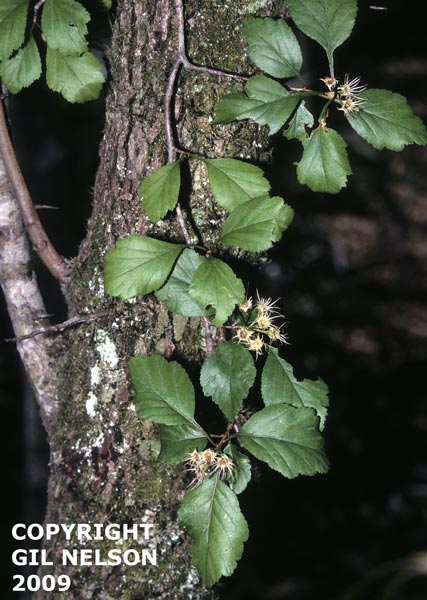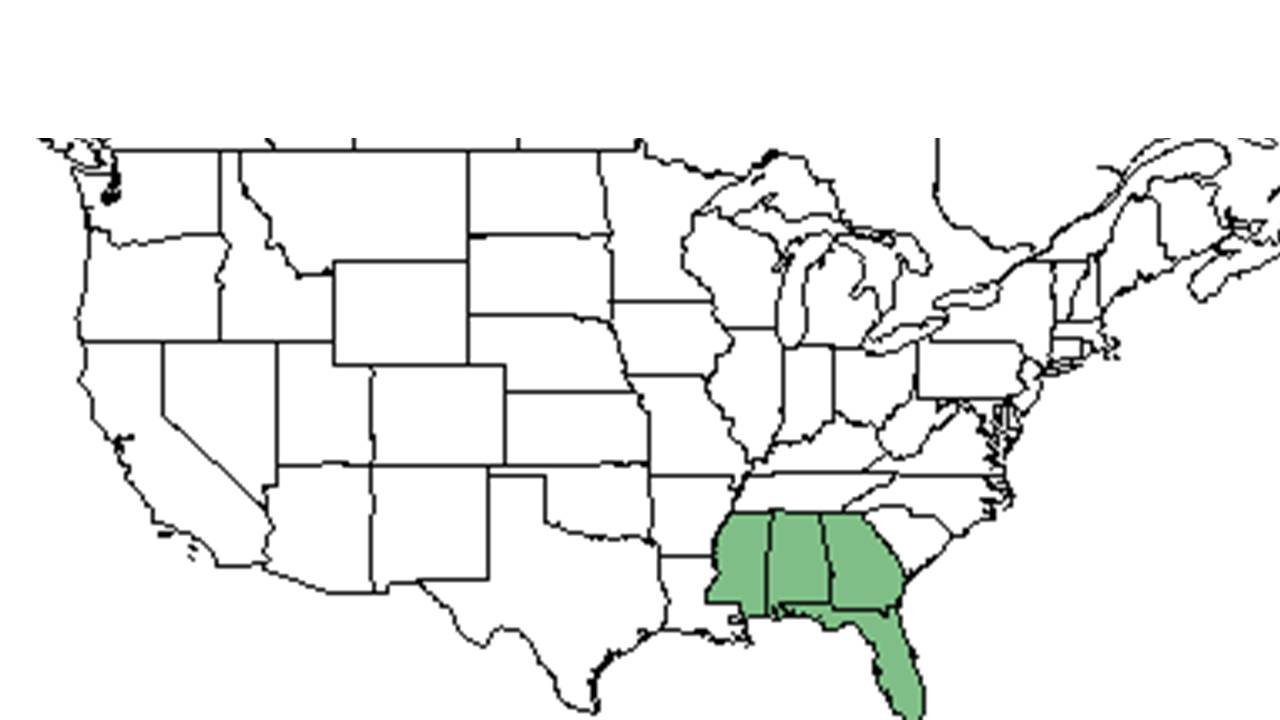Difference between revisions of "Crataegus pulcherrima"
HaleighJoM (talk | contribs) (→Ecology) |
|||
| (4 intermediate revisions by 3 users not shown) | |||
| Line 20: | Line 20: | ||
Common name: Beautiful hawthorn | Common name: Beautiful hawthorn | ||
==Taxonomic notes== | ==Taxonomic notes== | ||
| − | Synonyms: ''Crataegus | + | Synonyms: ''Crataegus abstrussa'' Beadle; ''C. austrina'' Beadle; ''C. opima'' Beadle; ''C. contrita'' Beadle; ''C. concinna'' Beadle; ''C. illustris'' Beadle; ''C. inanis'' Beadle; ''C. incilis'' Beadle; ''C. intricata'' Lange; ''C. lenis'' Beadle; ''C. macilenta'' Beadle; ''C. pinetorum'' Beadle; ''C. robur'' Beadle; ''C. tecta'' Beadle.<ref name="weakley">Weakley, A.S. 2015. Flora of the southern and mid-atlantic states. Working Draft of 21 May 2015. University of North Carolina at Chapel Hill, Chapel Hill, North Carolina.</ref> |
| + | |||
| + | |||
| + | Varieties: ''Crataegus pulcherrima'' Ashe ''var. opima'' (Beadle) R.W. Lance; ''Crataegus pulcherrima'' W.W. Ashe ''var. pulcherrima''.<ref name="weakley">Weakley, A.S. 2015. Flora of the southern and mid-atlantic states. Working Draft of 21 May 2015. University of North Carolina at Chapel Hill, Chapel Hill, North Carolina.</ref> | ||
| + | |||
==Description== | ==Description== | ||
<!-- Basic life history facts such as annual/perrenial, monoecious/dioecious, root morphology, seed type, etc. --> | <!-- Basic life history facts such as annual/perrenial, monoecious/dioecious, root morphology, seed type, etc. --> | ||
| Line 43: | Line 47: | ||
<!--===Fire ecology===--> <!--Fire tolerance, fire dependence, adaptive fire responses--> | <!--===Fire ecology===--> <!--Fire tolerance, fire dependence, adaptive fire responses--> | ||
<!--===Pollination===--> | <!--===Pollination===--> | ||
| − | <!--=== | + | <!--===Herbivory and toxicology===--> |
<!--===Diseases and parasites===--> | <!--===Diseases and parasites===--> | ||
| − | ==Conservation and | + | ==Conservation, cultivation, and restoration== |
Threats to this species include logging, clearing, and conversion of habitat to pine plantations and developments.<ref name=georgia>[[http://georgiawildlife.com/sites/default/files/uploads/wildlife/nongame/pdf/accounts/plants/crataegus_pulcherrima.pdf]]Georgia Wildlife. Accessed: April 15, 2016</ref> | Threats to this species include logging, clearing, and conversion of habitat to pine plantations and developments.<ref name=georgia>[[http://georgiawildlife.com/sites/default/files/uploads/wildlife/nongame/pdf/accounts/plants/crataegus_pulcherrima.pdf]]Georgia Wildlife. Accessed: April 15, 2016</ref> | ||
| − | + | ==Cultural use== | |
| − | == | ||
==Photo Gallery== | ==Photo Gallery== | ||
<gallery widths=180px> | <gallery widths=180px> | ||
Latest revision as of 08:20, 22 June 2022
| Crataegus pulcherrima | |
|---|---|

| |
| photo by Gil Nelson | |
| Scientific classification | |
| Kingdom: | Plantae |
| Division: | Magnoliophyta - Flowering plants |
| Class: | Magnoliopsida – Dicotyledons |
| Order: | Rosales |
| Family: | Rosaceae |
| Genus: | Crataegus |
| Species: | C. pulcherrima |
| Binomial name | |
| Crataegus pulcherrima Ashe | |

| |
| Natural range of Crataegus pulcherrima from USDA NRCS Plants Database. | |
Common name: Beautiful hawthorn
Contents
Taxonomic notes
Synonyms: Crataegus abstrussa Beadle; C. austrina Beadle; C. opima Beadle; C. contrita Beadle; C. concinna Beadle; C. illustris Beadle; C. inanis Beadle; C. incilis Beadle; C. intricata Lange; C. lenis Beadle; C. macilenta Beadle; C. pinetorum Beadle; C. robur Beadle; C. tecta Beadle.[1]
Varieties: Crataegus pulcherrima Ashe var. opima (Beadle) R.W. Lance; Crataegus pulcherrima W.W. Ashe var. pulcherrima.[1]
Description
A description of Crataegus pulcherrima is provided in The Flora of North America. Crataegus pulcherrima is a small understory tree, usually with a single main trunk and bushy crown. It's bark tends to be thickish, dark gray, and rough, or broken into small blocks.[2]
Distribution
Found from Mississippi to Georgia and northern Florida.[3]
Ecology
Habitat
C. pulcherrima can be found in upland mixed hardwood communities, longleaf pine-oak forests, longleaf pine-scrub oak sand ridges, and holly-mixed hardwood forests. It seems to prefer sandy soils, and can be found in well-drained soil occurring over limerock. This species also occurs more frequently in stands with a low second growth of hardwoods.[2]
Associated species include Longleaf pine, Loblolly pine, Shortleaf pine, and oak species.[2]
Phenology
C. pulcherrima has been observed flowering in January, March, April, and May with peak inflorescence in March and April.[4] Fruiting has been observed in May, June, September, and October.[2] C. pulcherrima reproduces sexually and does not spread vegetatively.[5]
Seed dispersal
Fruits are eaten by birds which disperse the seeds.[5]
Conservation, cultivation, and restoration
Threats to this species include logging, clearing, and conversion of habitat to pine plantations and developments.[5]
Cultural use
Photo Gallery
References and notes
- ↑ 1.0 1.1 Weakley, A.S. 2015. Flora of the southern and mid-atlantic states. Working Draft of 21 May 2015. University of North Carolina at Chapel Hill, Chapel Hill, North Carolina.
- ↑ 2.0 2.1 2.2 2.3 Florida State University Robert K. Godfrey Herbarium database. URL: http://herbarium.bio.fsu.edu. Last accessed: June 2014. Collectors: R. A. Norris, Robert K. Godfrey, and R. Komarek. States and Counties: Florida: Gadsden, Jackson, Leon, Wakulla, and Washington. Georgia: Grady.
- ↑ Phipps, J. B., R. J. O'Kennon, et al. (2006). "REVIEW OF CRATAEGUS SERIES PULCHERRIMAE (ROSACEAE)." SIDA, Contributions to Botany 22(2): 973-1007.
- ↑ Nelson, G. PanFlora: Plant data for the eastern United States with emphasis on the Southeastern Coastal Plains, Florida, and the Florida Panhandle. www.gilnelson.com/PanFlora/ Accessed: 8 DEC 2016
- ↑ 5.0 5.1 5.2 [[1]]Georgia Wildlife. Accessed: April 15, 2016